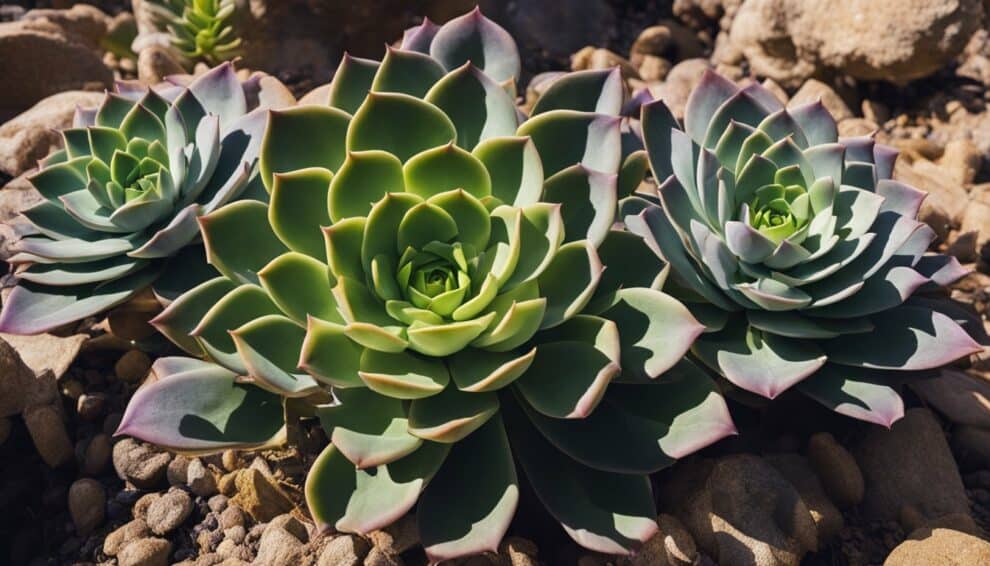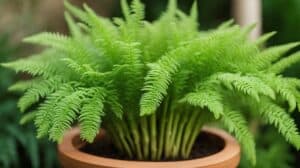Aeonium Arboreum, commonly known as Tree Aeonium or Irish Rose, is a unique succulent plant that is native to the Canary Islands.
With its striking appearance and easy-to-care-for nature, it has become a popular addition to indoor and outdoor gardens alike.
Its sculptural elegance and low maintenance requirements make it a perfect choice for both novice and experienced gardeners.

In this care guide, you will learn everything you need to know about the Aeonium Arboreum, including its origins, physical characteristics, and ideal growing conditions.
Whether you are looking to add a touch of natural beauty to your home or garden, or simply want to expand your plant collection, this guide will provide you with all the information you need to ensure your Aeonium Arboreum thrives.
So, let’s dive in and explore the world of Aeonium Arboreum together!
Understanding Aeonium Arboreum
Species Overview
Aeonium Arboreum, commonly known as Tree Aeonium, is a succulent plant that belongs to the Crassulaceae family.
It is native to the Canary Islands and Morocco and is widely cultivated in Mediterranean regions for its ornamental value.
The plant has a tree-like appearance, with a single stem that branches out into rosettes of fleshy leaves.
The leaves are green, red, or purple, depending on the variety, and can be glossy or matte.
Origins and Habitat
Aeonium Arboreum thrives in warm, dry climates and is well adapted to drought conditions.
In its native habitat, it grows in rocky, volcanic soils on hillsides and cliffs.
The plant is also found in coastal areas, where it can tolerate salt spray and high winds.
The Canary Islands have a subtropical climate, with mild winters and hot summers, and the plant is well-suited to these conditions.
Aeonium Arboreum has been cultivated for centuries and has been introduced to many parts of the world.
It is a popular ornamental plant in gardens, parks, and indoor spaces, and is valued for its sculptural elegance.
The plant is easy to care for and can be grown in a variety of conditions, making it a versatile addition to any collection.
Essential Care Instructions

Sunlight Requirements
Aeonium arboreum requires bright, direct sunlight to grow and thrive.
It is recommended to place the plant in a location where it can receive at least 6 hours of sunlight daily.
However, it is important to avoid exposing the plant to direct sunlight during the hottest part of the day as this can cause sunburn.
Watering Techniques
Aeonium arboreum is a drought-tolerant plant, but it still requires regular watering to stay healthy.
It is recommended to water the plant deeply but infrequently. Wait until the soil is completely dry before watering again.
Overwatering can lead to root rot and other issues, so it is important to avoid this.
Soil and Fertilization
Aeonium arboreum prefers well-draining soil that is rich in organic matter. It is recommended to use a cactus or succulent potting mix for this plant.
Fertilization is not necessary, but if desired, a balanced fertilizer can be applied during the growing season.
Temperature and Climate
Aeonium arboreum prefers warm temperatures and does well in a climate with mild winters and hot summers.
It can tolerate temperatures as low as 40°F (4°C) but it is best to keep the plant in a location where it can stay above 50°F (10°C).
In areas with colder temperatures, it is recommended to bring the plant indoors or provide some form of protection during the winter months.
Propagation and Repotting

Propagation Methods
Aeonium arboreum can be propagated through stem cuttings. To do this, select a healthy stem and make a clean cut with a sharp knife.
The cutting should be about 4-6 inches long. Allow the cutting to dry for a few days before planting it in well-draining soil.
The soil should be moist but not wet. Keep the soil moist until the cutting establishes roots, which usually takes about 4-6 weeks.
Another propagation method is through seed. However, this method is less common as Aeonium arboreum doesn’t produce seeds very often.
Repotting Steps
Repotting Aeonium arboreum is necessary when the plant outgrows its current container or the soil becomes compacted. Here are the steps to follow:
- Choose a pot that is slightly larger than the current one. Make sure the pot has drainage holes.
- Remove the plant from the current pot by gently loosening the soil around the roots.
- Inspect the roots for any signs of damage or disease. Trim any damaged or dead roots.
- Fill the new pot with well-draining soil. Make a small hole in the center of the soil.
- Place the plant in the hole and backfill with soil.
- Water the plant thoroughly and allow the excess water to drain out of the pot.
It’s important to avoid overwatering Aeonium arboreum after repotting.
Wait a few days before watering the plant again to allow the roots to settle in the new soil.
Pest Management and Troubleshooting

Common Pests
Aeonium Arboreum is generally resistant to pests, but they can still be susceptible to infestations.
Some common pests that can affect Aeonium Arboreum include mealybugs, spider mites, and scale insects.
These pests can be identified by the presence of small white, cottony masses on the plant or by the appearance of small, brown or black bumps on the leaves.
To control these pests, it is recommended to use a natural insecticide or to spray the plant with a solution of water and dish soap.
Disease Prevention
Aeonium Arboreum is also susceptible to fungal diseases such as root rot and leaf spot.
To prevent these diseases, it is important to avoid overwatering and to ensure that the plant is in well-draining soil.
Additionally, it is important to avoid getting water on the leaves as this can lead to the development of fungal diseases.
If the plant does develop a fungal disease, it is recommended to remove the affected leaves and to treat the plant with a fungicide.
Troubleshooting Tips
If your Aeonium Arboreum is not thriving, there are a few troubleshooting tips that you can try.
First, check to make sure that the plant is getting enough light.
Aeonium Arboreum requires bright, indirect light, so if the plant is not getting enough light, it may become leggy or the leaves may start to droop.
Additionally, make sure that the plant is not being overwatered. Overwatering can lead to root rot, which can cause the plant to wilt and die.
Finally, if the plant is not thriving, it may need to be repotted.
Aeonium Arboreum prefers to be in well-draining soil, so if the plant is in soil that is too heavy or compacted, it may not be able to grow properly.
Frequently Asked Questions

How can I encourage my Aeonium arboreum to branch out?
Aeonium arboreum will naturally branch out as it matures, but you can encourage branching by pruning the stem tips.
Trim the top 2-3 inches of the stem to promote branching and bushier growth.
What are some common issues with Aeonium arboreum and how can I address them?
Aeonium arboreum is susceptible to root rot if overwatered or planted in poorly draining soil.
To prevent root rot, make sure the soil is well-draining and allow the soil to dry out between watering.
Another common issue is sunburn, which can cause the leaves to turn brown.
To prevent sunburn, gradually introduce the plant to direct sunlight and provide shade during the hottest part of the day.
What are the best practices for indoor care of Aeonium arboreum?
Aeonium arboreum prefers bright, indirect light and well-draining soil. Water the plant thoroughly when the soil is dry to the touch, but avoid overwatering.
In the winter months, the plant may go dormant and require less water.
Is it possible to root Aeonium cuttings in water, and how should I do it?
Yes, it is possible to root Aeonium cuttings in water. Simply cut a stem section with a few leaves and submerge the cut end in water.
Change the water every few days and wait for roots to develop before transplanting to soil.
Can you propagate Aeonium arboreum from leaves, and what are the steps?
Yes, Aeonium arboreum can be propagated from leaves. Gently remove a leaf from the plant and allow the cut end to callus over for a day or two.
Plant the leaf in well-draining soil and water lightly. The leaf will eventually sprout roots and a new plant will grow from the base of the leaf.
What temperature conditions are ideal for the health of Aeonium arboreum?
Aeonium arboreum prefers moderate temperatures between 60-75°F (15-24°C).
Avoid exposing the plant to temperatures below 50°F (10°C) or above 90°F (32°C), as this can cause damage to the plant.














